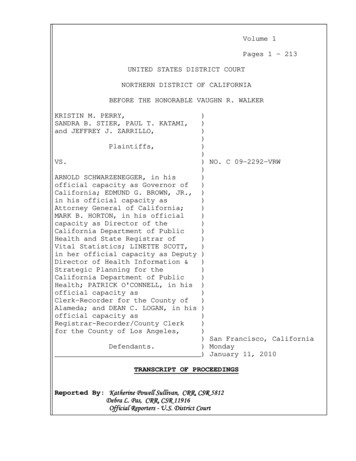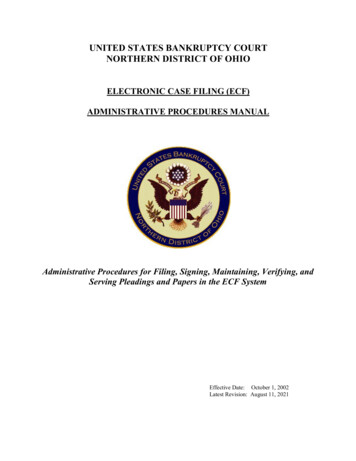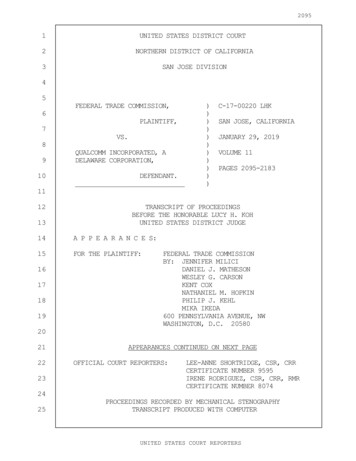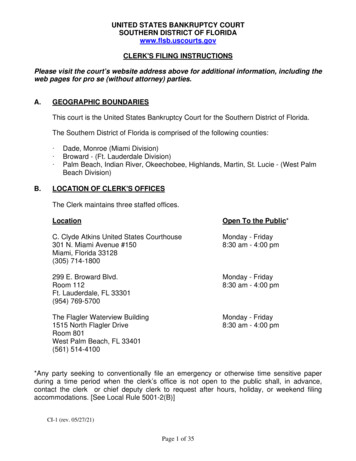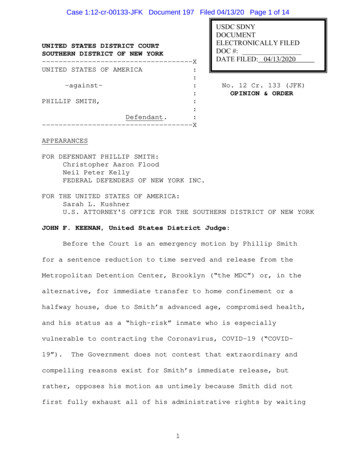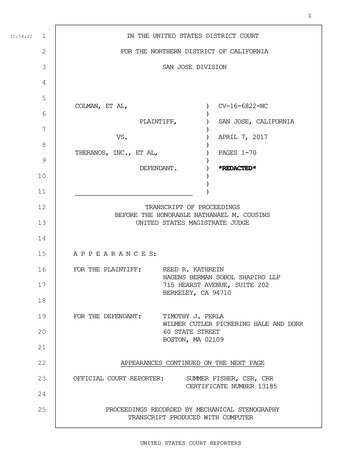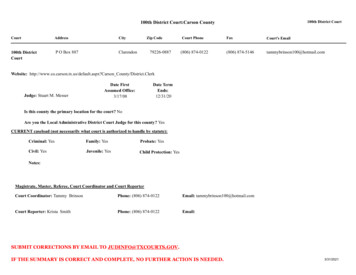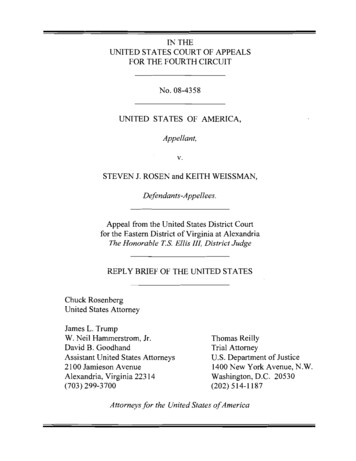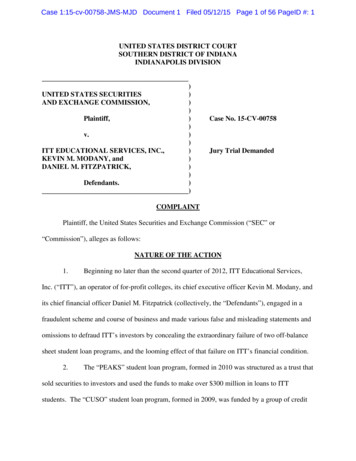
Transcription
Case 1:15-cv-00758-JMS-MJD Document 1 Filed 05/12/15 Page 1 of 56 PageID #: 1UNITED STATES DISTRICT COURTSOUTHERN DISTRICT OF INDIANAINDIANAPOLIS DIVISION)UNITED STATES SECURITIES)AND EXCHANGE COMMISSION,))Plaintiff,))v.))ITT EDUCATIONAL SERVICES, INC.,)KEVIN M. MODANY, and)DANIEL M. FITZPATRICK,))Defendants.))Case No. 15-CV-00758Jury Trial DemandedCOMPLAINTPlaintiff, the United States Securities and Exchange Commission (“SEC” or“Commission”), alleges as follows:NATURE OF THE ACTION1.Beginning no later than the second quarter of 2012, ITT Educational Services,Inc. (“ITT”), an operator of for-profit colleges, its chief executive officer Kevin M. Modany, andits chief financial officer Daniel M. Fitzpatrick (collectively, the “Defendants”), engaged in afraudulent scheme and course of business and made various false and misleading statements andomissions to defraud ITT’s investors by concealing the extraordinary failure of two off-balancesheet student loan programs, and the looming effect of that failure on ITT’s financial condition.2.The “PEAKS” student loan program, formed in 2010 was structured as a trust thatsold securities to investors and used the funds to make over 300 million in loans to ITTstudents. The “CUSO” student loan program, formed in 2009, was funded by a group of credit
Case 1:15-cv-00758-JMS-MJD Document 1 Filed 05/12/15 Page 2 of 56 PageID #: 2unions organized by ITT and made approximately 141 million in loans to ITT students. Toinduce the program participants to finance these risky loans, ITT provided guarantees thatlimited any risk of loss from the student loan pools. Default rates on the student loans had a keyimpact on these guarantees: if enough students defaulted, the guarantees were triggered and ITTwould be responsible for payments to the loan program participants.3.By 2012, the loans made through these programs had performed so abysmally,with extremely high default rates, that ITT’s guarantee obligations began to balloon. TheDefendants knew ITT faced looming, massive payments on these guarantees. However, ratherthan disclosing the significant impact of these guarantee obligations to ITT’s investors, theDefendants engaged in a series of deceptive acts to hide the poor performance of the student loanprograms and their financial impact on ITT. The Defendants also made numerous misstatementsand omissions – in ITT’s public filings and in conference calls with financial analysts – thatsimilarly concealed the condition of the student loan programs and ITT’s guarantee obligations.4.ITT, Modany, and Fitzpatrick hid the poor performance of the programs and theirimpact on the company in numerous ways. For example, in October 2012, after ITT received itsfirst demand for a multi-million dollar guarantee payment on the PEAKS program, Modany andFitzpatrick devised a plan whereby ITT actually made payments on behalf of student borrowerswho had failed to make timely payments, which had the effect of temporarily delaying furtherdefaults. This practice – which ITT later innocuously titled “Payments on Behalf of Borrowers,”or “POBOB” – had the effect of delaying tens of millions of dollars of looming PEAKSguarantee payments ITT would otherwise have had to make. The Defendants concealed thispractice from ITT’s investors (among others) and instead made statements in public filings that2
Case 1:15-cv-00758-JMS-MJD Document 1 Filed 05/12/15 Page 3 of 56 PageID #: 3led investors to believe the PEAKS program and its composite student loans were performingrelatively well.5.ITT, Modany, and Fitzpatrick further misled investors about the condition of thePEAKS program by consistently “netting” the near-term PEAKS guarantee payments ITTprojected making against speculative recoveries that were not projected to be realized until manyyears later. As a result, the net amount disclosed was tens of millions of dollars lower than themore than 100 million in near-term payments ITT projected making. The Defendants madenumerous misstatements and omissions regarding this “netting” practice, including falselyclaiming that this net amount represented the total amount of ITT’s future guarantee payments.6.In addition, the Defendants made only the minimum payments required on ITT’sCUSO guarantee – a practice akin to making minimum payments on a high interest credit card –but failed to disclose that this payment choice would have the effect of significantly increasingthe amounts ITT would ultimately owe. The Defendants also failed to consolidate the PEAKSprogram into ITT’s financial statements, which would have shown the declining value of PEAKSloans, despite having the sort of control over the program that should require consolidation.7.Finally, Modany and Fitzpatrick routinely misled ITT’s external auditor regardingimportant information affecting the PEAKS and CUSO programs, including internal projectionsabout future PEAKS and CUSO guarantee payments, a dispute with PEAKS programparticipants over the permissibility of POBOB, an unfavorable legal opinion regarding thepermissibility of POBOB, and information about ITT’s ability to remove the PEAKS loanservicer. The Defendants’ actions to mislead ITT’s auditor also helped to further the Defendants’fraudulent scheme.3
Case 1:15-cv-00758-JMS-MJD Document 1 Filed 05/12/15 Page 4 of 56 PageID #: 48.In early 2014, the Defendants’ scheme began to unravel. ITT’s auditor began tolearn previously undisclosed information regarding the PEAKS program, including the disputewith PEAKS program participants over the permissibility of POBOB. ITT ultimately restated itsfinancial statements to consolidate PEAKS for periods beginning in the first quarter of 2013 andto reclassify and disclose the timing for CUSO liabilities. In March 2014, ITT paid 40 millionto settle claims by PEAKS program participants that ITT circumvented its guarantee obligationsthrough POBOB. In its preliminary first quarter 2014 results, ITT disclosed that it was projecting 144 million of additional PEAKS payments, 116 million of which it expected to pay in 2014.ITT’s stock price dropped approximately 20% from already depressed prices. ITT has since paidmillions of dollars in additional PEAKS guarantee payments, based on the poor performance ofthe program.9.As a result of the conduct described herein, ITT, Modany, and Fitzpatrick violatednumerous provisions of the federal securities laws and unless restrained and enjoined willcontinue to do so.JURISDICTION AND VENUE10.The SEC brings this action pursuant to Section 20(b) of the Securities Act of 1933(“Securities Act”) [15 U.S.C. § 77t(b)] and Section 21(d) of the Securities Exchange Act of 1934(“Exchange Act”) [15 U.S.C. § 77u(d)]. The Court has jurisdiction pursuant to Section 22(a) ofthe Securities Act [15 U.S.C. § 77v(a)] and Sections 21(d), 21(e), and 27 of the Exchange Act[15 U.S.C. §§ 78u(d)-(e) and 78aa]. The Defendants, directly or indirectly, made use of themeans or instruments of transportation or communication in interstate commerce, the means andinstrumentalities of interstate commerce, or of the mails, in connection with the acts, practices,and courses of business set forth in this Complaint.4
Case 1:15-cv-00758-JMS-MJD Document 1 Filed 05/12/15 Page 5 of 56 PageID #: 511.Venue is proper in this Court pursuant to Section 22(a) of the Securities Act [15U.S.C. § 77v(a)] and Section 27(a) of the Exchange Act [15 U.S.C. § 78aa(a)] because theDefendants reside in this District and the acts, practices and courses of business constituting theviolations alleged in this Complaint occurred within this District and elsewhere.DEFENDANTSI.ITT12.ITT Educational Services, Inc. is a Delaware corporation with headquarters inCarmel, Indiana. ITT is a for-profit higher education company with more than 50,000 students atits campuses in 39 states and online. ITT’s stock is registered with the Commission pursuant toSection 12(b) of the Exchange Act, and is quoted on the New York Stock Exchange.13.ITT filed registration statements on Forms S-8 in May 2006 and May 2013 toregister shares of common stock under its equity compensation plan. ITT’s Form S-8 registrationstatements incorporated certain prior filings and all subsequently filed periodic reports. ITT’sofferings pursuant to these registration statements were ongoing during the time periodsimpacted by the Defendants’ misstatements and scheme, detailed below.14.ITT issued equity-based compensation based on these registration statements toits executives, board of directors, and other non-executive officer employees during the relevantperiod. ITT obtained the benefit of the services of these executives, directors, and employees byin part compensating them with equity-based compensation subject to these registrationstatements.II.Modany15.Kevin M. Modany, age 48, is a resident of Carmel, Indiana. During the relevantperiod, Modany was ITT’s chief executive officer (“CEO”) and chairman of its board of5
Case 1:15-cv-00758-JMS-MJD Document 1 Filed 05/12/15 Page 6 of 56 PageID #: 6directors, positions he had held since 2007 and 2008, respectively. Prior to that time, Modanywas ITT’s president and chief operating officer from approximately 2005 to 2007 and was ITT’schief financial officer (“CFO”) from approximately 2003 to 2005. Modany is also a certifiedpublic accountant (“CPA”) and was an auditor with a national accounting firm from 1990 to1995.16.Modany was significantly involved in the structure and operation of the loanprograms at issue in this case, as well as in ITT’s public filings and disclosures. Modany signedITT’s 2012 Form 10-K and certified each periodic filing during the time period relevant to thisComplaint. Modany (along with Fitzpatrick) had extensive input into these periodic filings: heedited and commented upon early drafts of the filings, reviewed the drafts after others hadcommented, and gave final approval before the filings were issued. As detailed below, thoseperiodic filings contained numerous false and misleading statements and omissions regarding thePEAKS and CUSO programs.17.Modany also signed management representation letters to ITT’s auditor for eachfiling period relevant to this Complaint. Those management representation letters also containedfalse and misleading statements and omissions.18.During the time period relevant to this Complaint, Modany received substantialcompensation from ITT in the form of salary, bonuses, and incentive and/or equity-basedcompensation.III.Fitzpatrick19.Daniel M. Fitzpatrick, age 55, is a resident of Carmel, Indiana. During therelevant period, Fitzpatrick was ITT’s CFO, executive vice president, and principal accountingofficer. Before joining ITT, Fitzpatrick was a senior vice president and controller for another for 6
Case 1:15-cv-00758-JMS-MJD Document 1 Filed 05/12/15 Page 7 of 56 PageID #: 7profit education company, as well as an auditor with a national accounting firm. Like Modany,Fitzpatrick is a CPA.20.Fitzpatrick was also significantly involved in the structure and operation of theloan programs at issue in this case, as well as in ITT’s public filings and disclosures. Fitzpatricksigned and certified each of ITT’s periodic reports during the time period relevant to thisComplaint. Fitzpatrick (along with Modany) had extensive input into these periodic filings: heedited and commented upon early drafts of the filings, reviewed the drafts after others hadcommented, and gave final approval before the filings were issued.21.Fitzpatrick also signed management representation letters to ITT’s auditor foreach filing period relevant to this Complaint. Those management representation letters alsocontained false and misleading statements and omissions.22.During the time period relevant to this Complaint, Fitzpatrick received substantialcompensation from ITT in the form of salary, bonuses, and incentive and/or equity-basedcompensation.FACTSI.ITT’s Dependence on Private Student Loans23.ITT is a for-profit education company. Nearly all of ITT’s revenues come fromtuition, which students pay using principally federal and state student loans. Like most for-profiteducation companies, ITT receives a significant amount of its revenue from federal student loanprograms under Title IV of the Higher Education Act of 1965 (“Title IV”). For example, in 2013,approximately 82% of ITT’s revenue came from Title IV funding. Federal regulations requirethat ITT, like other schools that receive Title IV funds, derive at least 10% of its revenue fromnon-Title IV sources.7
Case 1:15-cv-00758-JMS-MJD Document 1 Filed 05/12/15 Page 8 of 56 PageID #: 824.Historically, ITT’s students relied on traditional private education loans to pay fortuition and other costs not covered by Title IV grants, loans, and other sources, and ITT relied onthe students’ private loans to provide cash flow and critical non-Title IV revenue. However, inearly 2008, traditional private lenders generally ceased extending loans to students of for-profitcolleges, given those students’ high default rates.25.In 2008 and 2009, ITT tried but failed to secure a new source of private loans forits students. As a result, ITT extended “temporary credit” to students who were unable to pay thefull cost of tuition from other sources. Temporary credit was a short-term loan payable in asingle payment at the end of the academic year for which it was offered. Temporary credit hadthe effect of decreasing ITT’s reported income and other financial metrics, and further affectingITT’s cash flow. In addition, the revenue associated with temporary credit was not consideredpart of the 10% of revenue ITT was required to derive from non-Title IV sources.26.Beginning in 2009, ITT formed the two private student loan programs at issue inthis case – PEAKS and CUSO. Once those loan programs were in place, ITT used funds fromthe programs to pay off millions of dollars in temporary credit balances its students already owedto ITT, and to make new loans to ITT students.II.Defendants Devise the PEAKS and CUSO Private Student Loan Programs.27.The PEAKS and CUSO private student loan programs were complex structuresthat involved numerous parties outside of ITT providing money to fund student loans. ITT madea number of guarantees that mitigated these external parties’ risk of loss if the programsperformed poorly. A critical element of both student loan programs was the rate of studentdefaults: if a large number of students defaulted on their loans, ITT could be obligated to make8
Case 1:15-cv-00758-JMS-MJD Document 1 Filed 05/12/15 Page 9 of 56 PageID #: 9significant guarantee payments that would flow to the outside parties involved in the loanprograms.28.Modany and Fitzpatrick were extensively involved in the organization of both thePEAKS and CUSO programs and the negotiation of the relevant agreements.A.PEAKS29.In January 2010, ITT created the PEAKS (an acronym for “Program forEducation Access and Knowledge”) private student loan program. Under the terms of thePEAKS program, a bank issued loans to ITT students based on a commitment from a newlyformed trust (the “PEAKS Trust”) to purchase these loans. To finance the purchase of theseloans, the PEAKS Trust raised approximately 300 million by issuing senior debt to variousinstitutional investors (the “PEAKS Noteholders”). The PEAKS Trust received the cash flowsfrom the payments on the student loans and used those funds to pay the principal and interest ofthe senior debt, and other fees and expenses of the program. A student loan servicer wasresponsible for collecting the payments on the student loans.30.ITT guaranteed all of the principal and interest payments on the PEAKS seniordebt, as well as all other financial obligations of the PEAKS Trust. The PEAKS Trust wasrequired to pay off all of the senior debt by the beginning of 2020, either through student loancash flows or ITT’s guarantee payments.31.ITT also guaranteed that it would maintain a “parity ratio” between the PEAKSTrust’s assets (which essentially consisted of the value of the loans made to ITT’s students) andliabilities (which essentially consisted of the senior debt owed to the PEAKS Noteholders). ITTguaranteed that the value of the assets would at all times equal or exceed 105% of the liabilities.In practice, this meant that if the value of the Trust’s assets declined below the required parity9
Case 1:15-cv-00758-JMS-MJD Document 1 Filed 05/12/15 Page 10 of 56 PageID #: 10ratio, ITT was required to pay down the liabilities, i.e., the senior debt, until the ratio was back inbalance.32.Student loan defaults had a significant impact on the parity ratio. When PEAKSloans became 180 days delinquent, they were required to be written off for the purpose of theparity ratio calculation, thereby reducing the PEAKS Trust’s assets and decreasing the parityratio.33.If ITT did not make required guarantee payments, such as payments to preservethe parity ratio, when those payments were due, the PEAKS Noteholders could force ITT toimmediately pay the entire amount of principal and interest remaining on the senior debt ratherthan waiting for the 2020 maturity date.B.CUSO34.Prior to PEAKS, in 2009, ITT launched the CUSO private student loan program.ITT organized a group of credit unions that, acting through a Credit Union Service Organization(“CUSO”), made a total of approximately 141 million in private loans to ITT’s students overseveral years. Loans made in each year of the program were aggregated into one of three annualloan pools.35.ITT entered into a “risk sharing agreement” with the CUSO that was triggered ifmore than 35% of the loans in any of the three annual pools defaulted. Under the risk sharingagreement, ITT guaranteed payment of the principal, interest, and fees on any loans thatdefaulted over this 35% threshold (the “risk share threshold”).36.Under the CUSO risk sharing agreement, once ITT’s guarantee obligation wastriggered for one of the CUSO loan pools, ITT could choose to pay an amount equal to themonthly payments due on defaulted loans over the threshold (a minimum payment), or it could10
Case 1:15-cv-00758-JMS-MJD Document 1 Filed 05/12/15 Page 11 of 56 PageID #: 11discharge its total future obligation on those defaulted loans by immediately paying an amountequal to their outstanding principal plus some additional interest. In practice, the first option(making minimum monthly payments) cost ITT less in the short term than the second option(immediate discharge), but cost ITT more over the long term because of the accruing interestassociated with the monthly payments.C.PEAKS and CUSO Underwriting Criteria37.ITT wrote the loan underwriting criteria for the PEAKS and CUSO programs.The underwriting standards were extremely lenient. In addition, ITT was able to override thestandards if ITT had previously extended temporary credit to the borrower.38.The vast majority of PEAKS and CUSO borrowers had very poor credit profiles.Further, ITT students who accepted PEAKS and CUSO loans were required to pay very highcapitalized fees and adjustable interest rates. These interest rates ranged up to the U.S. primeinterest rate (“prime”) plus 10.5% for CUSO and prime plus 11.5% for PEAKS.III.PEAKS and CUSO are Initially Kept off ITT’s Balance Sheet.39.As Modany and Fitzpatrick knew, the PEAKS and CUSO programs weredesigned to enable ITT to avoid reporting their assets, liabilities, and financial performance inITT’s balance sheet and other financial statements.40.Both the PEAKS and CUSO programs are so-called variable interest entities, or“VIEs”. Under Generally Accepted Accounting Principles (“GAAP”), a company is required toconsolidate the assets, liabilities, and financial results of a VIE into its financial statements if,among other things, the company directs the activities that most significantly impact the VIE’seconomic performance.11
Case 1:15-cv-00758-JMS-MJD Document 1 Filed 05/12/15 Page 12 of 56 PageID #: 1241.ITT identified the establishing of loan underwriting criteria and the servicing ofthe loans as the activities that most significantly impacted the economic performance of thePEAKS and CUSO programs. However, ITT did not initially consolidate the PEAKS or CUSOprograms into its financial statements.42.Because ITT did not consolidate the PEAKS or CUSO programs into its financialstatements, ITT’s investors did not have direct information about the performance of theprograms or the component student loans.IV.Second and Third Quarters of 2012: ITT’s Student Loan Programs Begin toDeteriorate.43.From at least the end of 2011 through the end of the third quarter of 2012,PEAKS and CUSO loans were defaulting at extremely high rates. During this same time period,ITT’s financial performance and stock price were deteriorating due to declining enrollment andother issues affecting the for-profit college industry. In this environment, ITT’s management,investors, and stock analysts were particularly focused on ITT’s cash generation, cashobligations, and liquidity.44.During the second and third quarters of 2012, ITT used an internal model toestimate its liability for the PEAKS program by estimating the cash flows of the PEAKS Trustand ITT’s resulting guarantee payments. However, as the performance of the PEAKS Trustdeteriorated, the parity ratio the model calculated diverged significantly from the actual parityratio that was reported to and tracked by Fitzpatrick and others.45.By at least the second quarter of 2012, ITT was tracking the decliningperformance of the PEAKS loans. In June 2012, an institutional investor who was a PEAKSNoteholder asked Fitzpatrick about the decline of the PEAKS parity ratio. In response,12
Case 1:15-cv-00758-JMS-MJD Document 1 Filed 05/12/15 Page 13 of 56 PageID #: 13Fitzpatrick was told by ITT’s controller that the ratio had declined dramatically, from 119% to112% in the course of only three months.46.However, at the end of the second quarter of 2012, ITT’s internal model reflecteda parity ratio of 121%, far higher than the 112% ratio Fitzpatrick knew about in June 2012.47.ITT continued to track the declining parity ratio in the third quarter of 2012. InAugust 2012, ITT’s controller emailed Modany and Fitzpatrick a spreadsheet that showed furtherdecline of the PEAKS parity ratio, which by June 2012 had fallen to below 110%.48.Later in August 2012, ITT’s controller informed Fitzpatrick that the parity ratiohad fallen to 107%, and reiterated that 105% was the trigger point at which ITT would berequired to make guarantee payments to the PEAKS Trust. Fitzpatrick simultaneously received aPEAKS monthly statement which showed that over 67 million in PEAKS loans were thirty ormore days delinquent.49.In September 2012, Fitzpatrick received additional information indicating that thePEAKS parity ratio was about to be breached and that tens of millions of dollars of additionalloans were projected to default over the next few months. For example, on September 14, 2012,ITT’s controller told Fitzpatrick that if the PEAKS student loan assets declined by about 6million, the parity ratio would fall below 105%. Less than two weeks later, on September 27,2012, ITT’s controller forwarded Fitzpatrick an analysis of monthly PEAKS student loandefaults from ITT’s independent loan consultants that projected approximately 17 million instudent loan defaults in September, and more than 50 million in student loan defaults by the endof the year.13
Case 1:15-cv-00758-JMS-MJD Document 1 Filed 05/12/15 Page 14 of 56 PageID #: 1450.In October 2012, before ITT filed its Form 10-Q for the third quarter of 2012, ITTreceived a demand for a PEAKS guarantee payment of more than 8 million as a result of thebreach of the parity ratio. ITT made a payment to the PEAKS Trust in that amount.51.When ITT received this demand, Modany and Fitzpatrick almost immediatelybegan to analyze the PEAKS delinquent loans that would trigger additional payment demandsupon default. Based on these analyses, Modany and Fitzpatrick knew that severely delinquentPEAKS loans would have required additional projected PEAKS guarantee payments ofapproximately 30 million in the fourth quarter of 2012 alone.52.The Defendants misled ITT’s auditor by failing to disclose the growing disparitybetween ITT’s internal model and the actual PEAKS parity ratio. Fitzpatrick and ITT employeesunder his direction provided various information, including the results of ITT’s internal modelestimating the PEAKS liability, to ITT’s auditor in connection with the auditor’s review work inthe second and third quarters of 2012. As discussed above, that internal model reflected a farhigher parity ratio than the actual parity ratio that Fitzpatrick was monitoring. Even so,Fitzpatrick did not alert ITT’s auditor to the discrepancy between the actual parity ratio and theparity ratio calculated by ITT’s model.53.The fact that the parity ratio produced by the model did not agree with the actualparity ratio would have been significant to ITT’s auditor, as it bore upon the accuracy,reasonableness and reliability of the model ITT was using to project its PEAKS liability.14
Case 1:15-cv-00758-JMS-MJD Document 1 Filed 05/12/15 Page 15 of 56 PageID #: 15V.Fourth Quarter of 2012 through Second Quarter of 2013: Defendants Engage inFraudulent Conduct Surrounding the Poor Performance of PEAKS and CUSO,Including Concealing that Poor Performance from Investors.A.Defendants’ Make Payments on Behalf of Borrowers and Mislead ITT’sInvestors and Others about this Practice.i.54.Defendants Devise a Plan to Temporarily Avoid PEAKS GuaranteePayments.After receiving the PEAKS guarantee payment demand in October 2012, Modanyand Fitzpatrick devised a scheme for ITT to make relatively small payments on delinquentstudent loans in order to delay making much larger PEAKS parity ratio guarantee payments thatdefaults on those loans would trigger.55.ITT determined which students were about to default on their loans and made theminimum payment necessary to avoid default on their behalf, without advising the defaultingstudent that these payments were being made. Modany and Fitzpatrick implemented this scheme– which ITT later dubbed “Payments on Behalf of Borrowers,” or “POBOB” – with the goal toprevent any PEAKS loans from defaulting and thereby avoid all parity ratio guarantee paymentsthat would otherwise have been required based on actual student loan performance. Modany andFitzpatrick directed and approved the POBOB payments, monitored the amounts of payments,and were aware of the magnitude of the PEAKS loan balances impacted by the payments.56.At the end of October 2012, ITT made approximately 2.4 million of POBOBpayments, which prevented the subject loans from defaulting. As Modany and Fitzpatrick wereaware, the effect of these POBOB payments was to avoid approximately 30 million inguarantee payments to the PEAKS Trust that ITT would have been required to make to maintainthe parity ratio.15
Case 1:15-cv-00758-JMS-MJD Document 1 Filed 05/12/15 Page 16 of 56 PageID #: 1657.ITT continued making POBOB payments almost every month through the firstquarter of 2014. These POBOB payments were significant: they comprised approximately 44%of the cash the PEAKS Trust received from the student loan pool over the period from the fourthquarter of 2012 through the second quarter of 2013. Indeed, by the second quarter of 2013, ITTwas not making any parity ratio guarantee payments, but was instead only making POBOB.58.As Modany and Fitzpatrick knew, the practice of making POBOB paymentsrather than PEAKS guarantee payments resulted in lower monthly payment obligations, butincreased ITT’s overall PEAKS guarantee obligations. Unlike guarantee payments, which wouldpay down the PEAKS Noteholders’ principal, POBOB payments did not reduce ITT’s totalPEAKS liability. The POBOB payments instead increased ITT’s overall PEAKS liabilitybecause ITT essentially took over these student loans and their additional interest costs that ITTwas not otherwise obligated to pay. These effects compounded each period that ITT continuedthe practice.59.By the end of 2013, ITT had delayed tens of millions of dollars of guaranteepayments that would otherwise have been required.ii.60.Defendants Mislead ITT Investors about POBOB.From the fourth quarter of 2012 through the second quarter of 2013, ITT,Modany, and Fitzpatrick misled investors about the existence and impact of ITT’s POBOBpayments. As detailed below, the Defendants failed to disclose POBOB to investors, whichrendered various statements the Defendants did make misleading. Relatedly, the Defendants hadan obligation to disclose POBOB, particularly in the Management Discussion and Analysis(“MD&A”) portion of ITT’s public filings, but failed to do so. Finally, the Defendants made16
Case 1:15-cv-00758-JMS-MJD Document 1 Filed 05/12/15 Page 17 of 56 PageID #: 17several affirmative statements concerning PEAKS and the PEAKS Trust that were false andmisleading in light of POBOB.61.ITT, Modany, and Fitzpatrick misled investors through various statements inITT’s Forms 10-K, 10-Q, and 8-K during this period that were rendered false and misleading bythe Defendants’ failure to disclose information relating to ITT’s POBOB payments. Each ofthese filings contained various statements describing the PEAKS guarantee and disclosing theamounts of guarantee payments ITT made in the each relevant period. By making thesestatements without disclosing POBOB, the Defendants gave ITT’s investors the false appearancethat the PEAKS program and its composite student loan pools were performing relatively well,even though the Defendants knew that PEAKS student loans were defaulting at significant ratesand ITT was merely delaying tens of millions of dollars in guarantee payments by makingPOBOB.62.For example, ITT’s 2012 Form 10-K disclosed that ITT “guarantee[d] payment ofthe principal, interest and certain call premiums owed on the
Carmel, Indiana. ITT is a for-profit higher education company with more than 50,000 students at its campuses in 39 states and online. ITT's stock is registered with the Commission pursuant to Section 12(b) of the Exchange Act, and is quoted on the New York Stock Exchange. 13. ITT filed registration statements on Forms S-8 in May 2006 and May .
